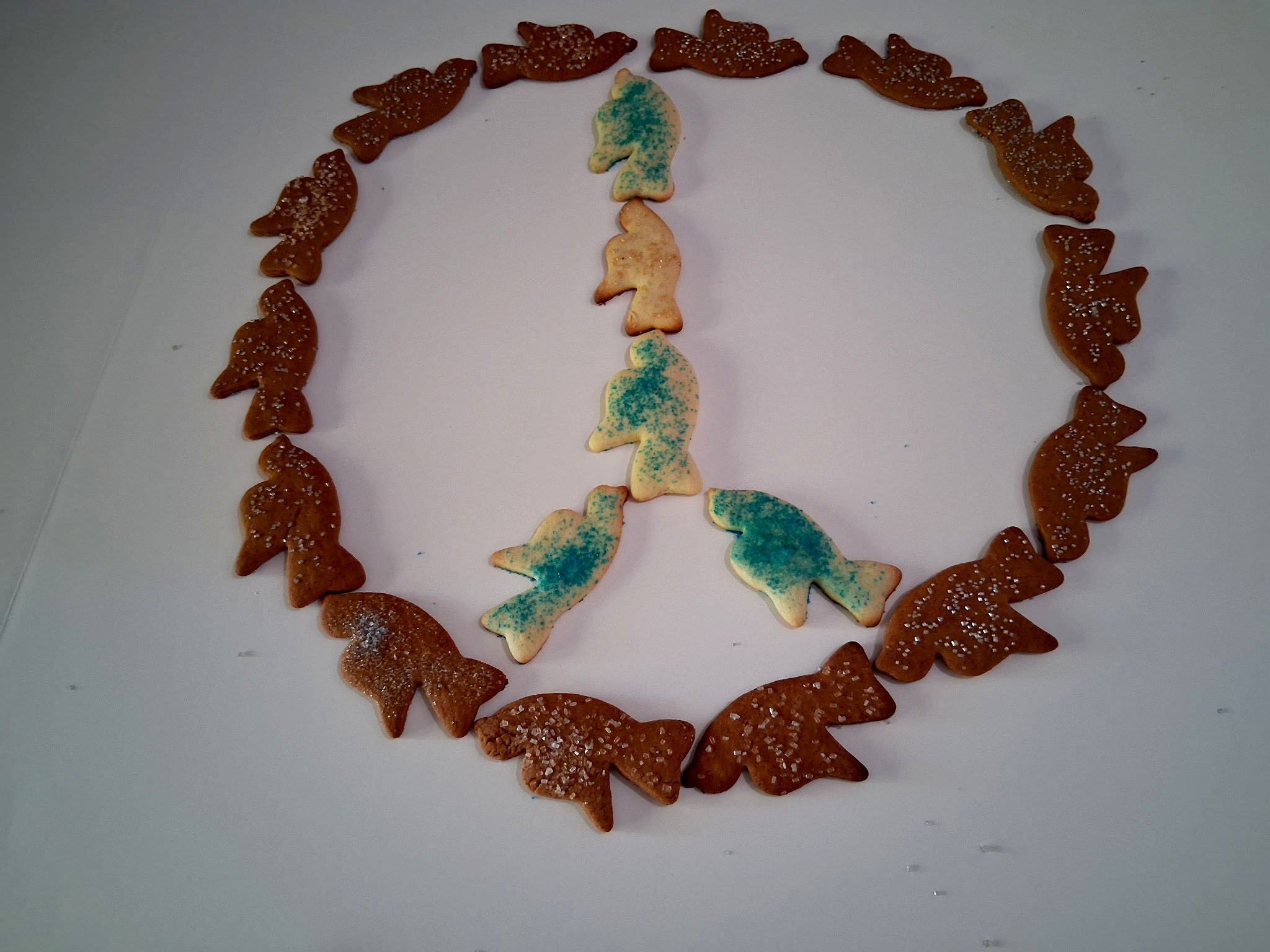Dear Olive Branch
Topic: Peaceful Pathways
When I think of Peaceful Pathways, the image of a winding path through woods and meadows comes to my mind. I can remember the feeling of the warm sun on my back, the smells of wildflowers and pine trees coming in waves carried by the gentle breeze. Ah, I am transported to a happy place. As I think more about peaceful pathways, I wonder how many other people have a similar feeling about some peaceful path.
As we interact with others in our worlds, we sometimes realize that we are not always in a peaceful setting. A “peaceful feeling” is not a constant state of mind, but one that we strive to experience now and again.
There are practices, habits, and so on, that can be developed to help us find our own peaceful path. In the following stories some of these techniques are implemented. The story about the peace vigil has a base on communication, cooperation, respect and inclusion. In “Saving the Tree” conflict management and advocacy are used. The article about HeadStart is focused on having goals, being persistent, and looking for and accepting help when needed. [M. Shelton]
Working Together to Bring Peace
A few months ago, people from local faith communities were asked to attend a meeting to see if we could develop a project to all do together. After several discussions we decided on creating a peace vigil and inviting all the churches, temples, and synagogues in the community to participate. We decided to hold it during the end of September, close to the International Day of Peace.
Now what? Where would we hold the vigil? What would it look like? One of the pastors in our group volunteered his church. We decided on a Sunday at twilight. We asked each church leader to offer a peace prayer, then agreed to invite everyone to write a prayer to put in a big basket. Someone said they would bring a peace pole and flowers. And one of the pastors really likes candles, so we agreed to have those. Two musicians will play soft guitar music as people are writing their prayers. We’ll end the vigil with sharing peace dove cookies and getting to know each other.
What amazed me during this whole process is that we started out as a group of people who really didn’t know each other. One woman had an idea to have faith communities do something together. She invited us to the first meeting. We listened to everyone’s ideas and came up with something that we hope to make an annual event to bring people together in an often-divided world… one step at a time. [J. Daniels]
Saving the Tree: Managing a Conflict
One day a number of years ago, at California State University, Fullerton, Children’s Center, the four-year-olds ran outside for their usual play time. There, they discovered their teacher in distress talking to a groundskeeper from the university who had been told to cut down the liquid amber tree by the back door. The tree was much valued for its shade, leaves which turned a beautiful yellow in the fall, and especially as the pet chicken’s evening roost. The four-year-olds stopped dead in their tracks upon seeing the chain saw, which the groundskeeper held, and demanded to know what was going on. Upon hearing the problem, that he needed to cut down the tree, they all spoke at once. They told the now also distressed groundskeeper why he must NOT cut down the tree. With 20 four-year-old children and their teacher giving reasons such as, “The chicken will have nowhere to sleep,” the astounded groundskeeper said he would discuss the problem with his boss. The children also wanted to contact the boss, so he told them the name of his boss so that they could “write” a letter to the boss. Later, the teacher took dictation from the children and the letter was sent. The liquid amber tree lived on at the Children’s Center for quite a number of years…
In what ways had the teacher been working all year to enhance the children’s ability to speak out - to make their voices heard? The children knew it was their job to take care of the tree. They knew that they were capable of speaking up with confidence. It wasn’t someone else’s job - they were there at that time. They trusted their own ability in the process of taking action. The children had many experiences with fairness for all; therefore, saving the tree for the chicken seemed only natural. It never occurred to the children that they did not have the power and authority to stand up to the groundskeeper in the face of an injustice - shared authority had been practiced all year. The children were obviously adept problem solvers: they wrote a letter to the boss. And they certainly understood the need to share our resources. Children who can speak out for justice will become adults who can use democratic practice to make our world a better place for all to live. These children are well on their way to becoming collaborators in creative problem solving. [S.Hopkins]
Peaceful Pathways in Head Start
When I was a young mom of two children, I returned to college to finish a degree in child development. I was able to get a Pell Grant so that I could afford to attend school. My husband had the GI bill, so we had an income, which was almost enough to stretch to cover food, shelter and clothing, and not much more. I was grateful for the Women, Infants and Children [WIC] program which made the budget for food stretch further. Like all mothers, I wanted the best for my children, and I could not afford to send my children to the childcare center on campus. I found out about a homebased Head Start program, so I enrolled my four-year-old. My two-year-old was not old enough yet. The program was great. The home-based visitor brought activities to do with my children.
I made toys for my children out of leftover parts and pieces: worn out clothes, and pieces from a broken crib. I made do with the creativity that comes with not having much of anything, but I did have the know-how of innovation. When my husband graduated, he was able to get a job in another state. I packed us and all our possessions, and we moved in our old VW Pop-Up Van. I discovered that it takes a lot of years to get out of having an extremely limited income. I still made clothes and toys so that the money would go farther.
Fast forward many years. I finally finished my bachelor’s degree in early childhood education after transferring from one college to another as my husband got promoted. I moved again when my husband became my “wasband.” All four of my children were in the public-school systems and doing well. As a single mom, I needed to get employment. I was lucky enough to be hired by Head Start as a home visitor. I did not make much, but I had the freedom to create my own schedule so that I could get my children on and off their school buses. The government helped a little bit since my children were on the Free and Reduced Meals [FARM] program.
I was able to help many families make the most of what they had. We developed long and short-term plans to help them survive with not much money and to create better futures for their families. In our rural area, some of the housing that they were living in broke my heart. Sometimes, the floors did not meet the walls; often the water pumps were broken. Some families still had outhouses. What I learned was that all families want the best for their children and will do what is needed if they can get just a little bit of help, and have a little bit of hope.
I discovered I could get some money and parts and pieces from a thrift shop run by the Head Start program. I taught the families to replace doors and fix windows. One family’s floor was falling apart, so we scraped enough money together to replace the floor. The older children in the family helped with hammering the new boards to the joists. The families discovered self-sufficiency and were enthusiastic about taking control of their own lives.
In my home visiting the Head Start group there was a young 16-year-old mother of three children. Her own single mother died, which left her responsible for her four younger siblings, along with her own three. She found a four-room house that had been overrun by chickens and we rehabilitated it. There was a hand water pump outside and an outhouse. I ran into this woman several years later, and discovered that she had gotten a fairly nice trailer to live in. She put herself through the two-year college, and got herself a job working at the college, and then went on to get her four-year degree. Her children were doing well at the public schools. I was very proud of that family!
An interesting perspective on the efficacy of Head Start Budget
They were allocated $2.27 billion for the entire fiscal year 2024. During that time period, the US military spent approximately $2.25 billion for just one day. [D. Satterlee]
NOTE: We chose “Dear Olive Branch” as the title for this column for several reasons – foremost as a sign of peace. Also, olives come in many colors, sizes, tastes, uses – a sign of diversity just as there are many types of questions and those who send the questions. We hope Olive’s responses will help you, the reader – if you have a question for Olive, send it to our email address. When Olive isn’t available to answer questions, members of EPCC and/or P.E.A.C.E. will step up to help.
Olive’s Future Columns
We are looking for your questions and/or short stories to be considered for inclusion in the future. Word range: 150-300 words.
This article is part of our Newsletter 2025 Issue 4. See all articles.
Share article




